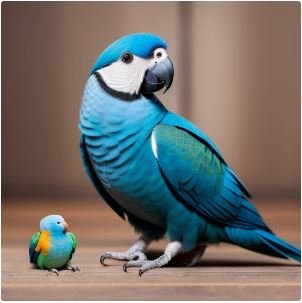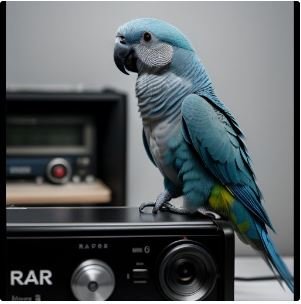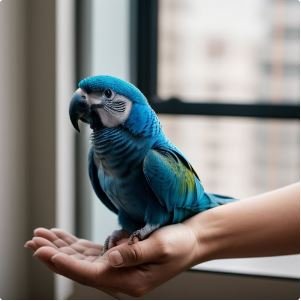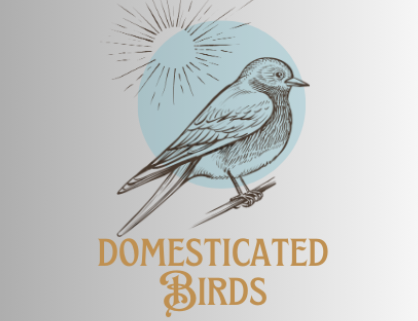Introduction to Blue Quaker Parrots
Overview of Blue Quaker Parrots: Blue Quaker Parrots, known for their vibrant plumage and intelligent nature, make delightful companions for bird enthusiasts. These charming birds are not only visually striking but also possess a remarkable ability to mimic human speech.
Why Train Your Blue Quaker Parrot to Talk: Training Blue Quaker Parrot to talk can enhance the bond between you and your feathered friend while providing mental stimulation and enrichment for the parrot. Moreover, it’s a fascinating aspect of bird ownership that brings joy and amusement to both you and your pet.
Understanding the Blue Quaker Parrot’s Capacity for Speech
Natural Vocal Abilities: Blue Quaker Parrots have an innate talent for vocal mimicry, often displaying a keen interest in imitating sounds from their environment.
Factors Affecting Learning Capacity: The learning capacity of Blue Quaker Parrots varies based on factors such as age, individual personality, and the training techniques employed by their owners.
Preparing for Training Blue Quaker parrot to talk
Creating the Right Environment: Providing a conducive environment free from distractions is crucial for training blue quaker parrot to talk.

Building Trust with Your Parrot: Establishing trust forms the foundation of successful training. Spend quality time bonding with your parrot to foster a strong relationship built on trust and mutual respect.
Training Blue Quaker Parrot to Talk
Essential Training Techniques
1. Positive Reinforcement Methods
Positive reinforcement is a highly effective technique for training Blue Quaker Parrot to talk. By rewarding your parrot with treats or praise when they exhibit the behavior you want, you reinforce that behavior and increase the likelihood of it recurring.
For Example: Suppose you’re teaching your Blue Quaker Parrot, named Luna, to say the word “hello.” Every time Luna attempts to mimic the word “hello,” you immediately offer her a small treat or verbal praise. Over time, Luna associates saying “hello” with receiving a reward, motivating her to continue practicing the behavior.

2. Repetition and Consistency
Consistency and repetition are crucial aspects of training any animal, including Blue Quaker Parrots. By consistently repeating words or phrases during training sessions, you help reinforce the association between the sound and its meaning in your parrot’s mind.
For instance: Let’s say you’re teaching your Blue Quaker Parrot, named Sky, to say the phrase “good bird.” During each training session, you repeatedly say “good bird” in a clear and consistent manner while offering rewards for correct attempts. Through consistent repetition, Sky gradually learns to associate the phrase with positive reinforcement and is more likely to mimic it in the future.
3. Vocal Mimicry Exercises
Blue Quaker Parrots have a natural talent for mimicking sounds, including human speech. Engaging in vocal mimicry exercises can help stimulate your parrot’s interest in learning new words and phrases.
Practical Example: To encourage vocal mimicry in your Blue Quaker Parrot, you can play word association games. For instance, you might say a word like “apple” and then encourage your parrot to repeat it. Repeat this exercise with different words, gradually increasing the complexity of the vocabulary. Additionally, mirror training can be effective. Place a mirror near your parrot’s perch and say words or phrases while pointing to the mirror. Your parrot may be intrigued by its reflection and attempt to mimic the sounds it hears.

Owner Testimonial:
“Mirror training was a game-changer for my parrot, Sky. He would spend hours interacting with his reflection and gradually started mimicking the sounds he heard.” – Emily Johnson.
4. Target Training
Target training involves teaching your Blue Quaker Parrot to touch a specific object, often with its beak or feet. This technique not only enhances your parrot’s cognitive abilities but can also be seamlessly integrated into speech training.
Let’s understand with Example: Let’s say you want to teach your Blue Quaker Parrot, named Rio, to associate the word “target” with touching a stick. Hold the stick near Rio and say “target” while encouraging him to touch the stick with his beak. When Rio successfully touches the stick, offer a treat or praise. Eventually, you can incorporate this into speech training by associating specific words with target actions, reinforcing both physical and vocal responses.
5. Modeling Speech Patterns
Modeling speech patterns involves speaking clearly and slowly to help your Blue Quaker Parrot understand and mimic human speech more effectively.
For Example: Suppose you are teaching your parrot, Coco, to say the phrase “I love you.” Pronounce each word clearly and at a moderate pace. Repeat the phrase consistently during training sessions, emphasizing the correct pronunciation. By modeling the speech pattern, Coco learns not only the words but also the proper enunciation and rhythm, making it more likely for him to replicate accurately.
6. Utilizing Audio Recordings
Playing recorded speech or other sounds can provide additional stimuli for your Blue Quaker Parrot to mimic. This technique broadens their exposure to different tones and words.
Practical Example: Create a recording of yourself saying common phrases or words you want your parrot to learn. Play this recording during specific training sessions. For example, if you’re trying to teach your parrot, Mango, to say “hello,” play the recording repeatedly. Mango, intrigued by the familiar sound, may start attempting to imitate the words he hears on the recording.

Owner Testimonial:
“I found that incorporating audio recordings into training added a dynamic element to the sessions. My parrot, Kiwi, started mimicking not only my live speech but also words he heard in the recordings.” – Alex Turner.
Tailoring Techniques: Training Blue Quaker parrot to talk
Understanding the Unique Characteristics of Blue Quaker Parrots: Recognizing their social nature, intelligence, and playfulness helps tailor training methods to suit their individual needs.
Adapting Traditional Methods: Modify training schedules, reward systems, and communication styles to align with your parrot’s preferences and behaviors.
Avoiding Common Pitfalls: Prevent overwhelming your parrot with excessive information, avoid punishment-based methods and prioritize socialization to ensure a positive learning experience.
Advanced Training Strategies:
Expanding Vocabulary
1. Introducing New Words: When expanding your Blue Quaker Parrot’s vocabulary, start with simple, commonly used words or phrases.
For instance, consistently saying “hello” or “goodbye” every time you enter or leave the room provides context for your parrot to learn these greetings. Once your parrot associates the word with the action, they’ll start mimicking it. Additionally, you can introduce new words during interactive play sessions or meal times, associating specific words with certain activities or objects.
2. Contextual Learning: Contextual learning involves associating words with specific situations or objects.
For example, if you regularly say “water” when refilling your parrot’s water dish, they’ll learn to associate that sound with the action of drinking water. Similarly, saying “treat” whenever you offer a reward reinforces the connection between the word and the positive experience of receiving a treat. This method helps your parrot understand the meaning behind the words they’re learning, facilitating faster acquisition and retention.
Owner Testimonial:
“To expand my parrot’s vocabulary, I started incorporating new words into our daily interactions. For example, I would say ‘Hello’ every time I entered the room, and soon enough, my parrot, Kiwi, began greeting me in return.” – John Doe.
3. Incorporating Names and Commands: Introducing the names of family members, pets, or specific toys into your parrot’s vocabulary enhances their communication skills and strengthens their bond with individuals and objects.
Similarly, teaching commands like “step up” or “step down” during training sessions provide your parrot with essential cues for desired behaviors. Consistent repetition and positive reinforcement help solidify these associations over time.
Polishing Pronunciation
1. Correcting Errors Gently: When your parrot attempts to mimic words but mispronounces them, gently correct them by repeating the word with the correct pronunciation. Avoid using negative reinforcement or harsh corrections, as they can discourage your parrot from attempting to speak. Instead, maintain a positive and encouraging tone to motivate your parrot to keep trying.
Practical Example: If your parrot says “hewwo” instead of “hello,” respond with a clear and correct pronunciation of the word “hello” without sounding critical. Your parrot will gradually learn to mimic the correct pronunciation through positive reinforcement.
2. Targeting Problematic Sounds: Some words or sounds may pose challenges for your parrot due to their unique vocal anatomy. Identify specific sounds that your parrot struggles with and incorporate targeted exercises to help them improve. For instance, if your parrot has difficulty with “r” sounds, practice words containing that sound more frequently and reward attempts at pronouncing it correctly.
For instance: If your parrot struggles with the “r” sound in the word “bird,” repeat the word slowly and clearly, emphasizing the correct pronunciation of the “r” sound. Reward your parrot’s attempts at replicating the sound, gradually increasing the complexity as they improve.
Encouraging Conversational Skills
1. Engaging in Dialogues: Encourage conversational skills by initiating simple dialogues with your parrot. Ask questions or make statements that prompt responses, such as “How are you?” or “What’s that?” Wait for your parrot to respond, even if it’s just with sounds or gestures, and positively reinforce their efforts.

Example: During mealtime, ask your parrot, “Are you hungry?” and wait for a response. If they make vocalizations or nod their head, respond enthusiastically with praise and offer their food as a reward. Over time, your parrot will learn to engage in these conversational exchanges more actively.
2. Encouraging Turn-Taking: Teach your parrot the concept of turn-taking in conversations by pausing after speaking and giving them an opportunity to respond. This helps develop conversational flow and encourages your parrot to actively participate in interactions.
Example: After saying a simple phrase like “Good morning,” pause and wait for your parrot to make a vocalization or gesture in response. If they do, acknowledge their contribution and continue the conversation. Gradually increase the complexity of interactions as your parrot becomes more proficient in turn-taking.
Monitoring Progress and Adjusting Techniques
- Tracking Vocabulary Expansion
Tracking your Blue Quaker Parrot’s vocabulary expansion is essential to understanding its learning pace and areas of improvement. You can maintain a simple record, noting down new words or phrases your parrot successfully mimics during training sessions.
Example: Imagine you’ve been teaching your parrot the word “apple” for some time, but it hasn’t picked it up yet. However, during a training session, you notice it spontaneously saying “apple” after seeing you eat one. This indicates that your parrot has made a connection between the word and the object. You can then focus more on reinforcing this association by consistently using the word “apple” in different contexts, such as during playtime or while offering treats.
- Recognizing Signs of Improvement
Recognizing signs of improvement in your Blue Quaker Parrot’s speech and behavior is crucial for reinforcing positive progress. These signs can include clearer pronunciation of words, increased vocalization, or more frequent attempts to mimic human speech. By actively observing your parrot’s responses during training sessions, you can identify areas where it’s excelling and areas that may require more attention.
Example: Let’s say you’ve been working on teaching your parrot the phrase “good morning” for a while. Initially, it struggled to pronounce it clearly, but over time, you notice a significant improvement in its articulation. Moreover, your parrot now greets you with “good morning” not only in the morning but also throughout the day. This indicates that your parrot has successfully learned the phrase and is comfortable using it in different contexts, showcasing tangible progress in its speech training.

- Modifying Training Approaches as Needed
Modifying your training approaches based on your Blue Quaker Parrot’s responses and progress is essential to ensure effective learning. If you notice that certain techniques or exercises are not yielding the desired results, don’t hesitate to try new methods or adjust your existing ones. Flexibility in your approach allows you to tailor the training experience to suit your parrot’s individual needs and learning style.
Example: Suppose you’ve been using a clicker training method to reinforce your parrot’s speech, but you find that it’s becoming less responsive to the clicker sound over time. In this case, you might decide to switch to a verbal cue or a different type of reinforcement, such as offering its favorite treat immediately after it successfully mimics a word. By adapting your training approach in response to your parrot’s changing preferences, you can maintain its engagement and motivation during training sessions.
- Documenting Training Sessions: Maintain a training log to monitor progress and identify areas for improvement.
- Seeking Feedback from Others: Consult with experienced bird owners or avian professionals for valuable insights and feedback on your training techniques.
Troubleshooting and Tips
Addressing Common Training Roadblocks
1. Lack of Interest or Engagement: Sometimes, Blue Quaker Parrots may lose interest or show reluctance during training sessions. To address this, try to make the sessions more engaging and rewarding. Introduce new toys or treats to pique their interest and vary the training activities to keep them stimulated. Additionally, observe your parrot’s body language for signs of disinterest, and if needed, take short breaks or adjust the training schedule to prevent fatigue.
2. Difficulty in Pronunciation: Pronunciation challenges are common during speech training. If your parrot struggles with certain sounds or words, be patient and provide gentle correction. Break down complex words into smaller syllables and practice them gradually. Repeat the word in a clear and distinct manner, and reward your parrot for any attempts at mimicking the correct pronunciation. Consistent practice and positive reinforcement will help improve your parrot’s pronunciation over time.
3. Regression in Speech: It’s not uncommon for Blue Quaker Parrots to experience periods of speech regression, where they may forget previously learned words or phrases. This can occur due to various factors such as stress, changes in environment, or lack of reinforcement. To address speech regression, revisit familiar words and phrases during training sessions to refresh your parrot’s memory. Offer plenty of encouragement and rewards for any attempts at vocalization and maintain a consistent training routine to reinforce learned behaviors.
Strategies for Overcoming Challenges
1. Patience and Persistence: Training Blue Quaker Parrot to talk requires patience and persistence. Avoid becoming frustrated or impatient if progress seems slow, as this can negatively impact your parrot’s willingness to learn. Instead, maintain a calm and positive attitude during training sessions, and celebrate even small achievements. Consistently reinforce desired behaviors with rewards and encouragement and remember that each parrot learns at its own pace.
2. Dealing with Shyness or Aggression: Some Blue Quaker Parrots may exhibit shyness or aggression, particularly if they feel threatened or stressed during training. To address shyness, create a safe and comfortable training environment free from loud noises or sudden movements. Approach your parrot calmly and speak to them in soothing tones to build trust and confidence. For aggression, avoid confrontational behavior and instead, use positive reinforcement techniques to encourage calm and cooperative behavior.
3. Handling Distractions: External distractions can hinder effective training sessions with your parrot. To minimize distractions, choose a quiet and secluded area for training, away from noisy household activities or other pets. Close windows and doors to reduce outside noises and turn off electronic devices that may disrupt focus. Additionally, maintain a consistent training schedule and limit training sessions to short, focused intervals to maximize attention and minimize distractions.
Tips for Encouraging Vocalization
1. Playing Recordings of Human Speech: Playing recordings of human speech can help stimulate your parrot’s interest in vocalization and provide additional auditory cues for mimicry. Choose recordings with clear and distinct speech patterns and play them during quiet moments or as background noise throughout the day. Encourage your parrot to vocalize along with the recordings and reward them for any attempts at mimicking the sounds.
2. Incorporating Background Noise: Background noise, such as gentle music or ambient sounds, can create a conducive environment for speech training. Low-level background noise can help mask distractions and create a calming atmosphere for your parrot to focus on vocalization. Experiment with different types of background noise to find what works best for your parrot and incorporate it into your daily routine during training sessions.
3. Engaging in Regular Conversations with Your Parrot: Engaging in regular conversations with your parrot is essential for encouraging vocalization and strengthening the bond between you. Talk to your parrot in a clear and expressive manner, using simple words and phrases that are easy for them to understand. Encourage your parrot to respond with vocalizations or mimicry and reward them for their efforts. Regular interaction and communication will help reinforce learned speech patterns and encourage further vocalization in your parrot.
Conclusion
Training Blue Quaker parrot to talk involves positive reinforcement, repetition, and tailored techniques to suit the individual needs of your Blue Quaker Parrot. Patience and consistency are key to successful speech training, fostering a strong bond and mutual understanding between you and your parrot. Celebrate your parrot’s milestones and accomplishments along the training journey, reinforcing positive behaviors and strengthening your bond.
FAQs: Training Blue Quaker parrot to Talk.
Can all Blue Quaker Parrots learn to talk?
While individual abilities may vary, most Blue Quaker Parrots have the potential to learn speech through consistent training and positive reinforcement.
How long does it typically take training Blue Quaker Parrot to talk?
The timeframe for speech training varies depending on factors such as the parrot’s age, personality, and the training methods used. With patience and consistency, some parrots may start mimicking speech within a few weeks to several months.
What if my Blue Quaker Parrot refuses to mimic speech?
If your parrot shows reluctance, try adjusting your training approach, incorporating enticing rewards, and creating a supportive environment to encourage participation.
Are there any age limitations for training Blue Quaker Parrot to talk?
While younger parrots tend to learn more quickly, older Blue Quaker Parrots can also be trained with patience and persistence, though it may take longer to see results.
How can I prevent my Blue Quaker Parrot from picking up undesirable words or sounds?
Monitor interactions and avoid reinforcing undesirable behaviors by redirecting focus to positive speech patterns and rewarding desired vocalizations consistently.

